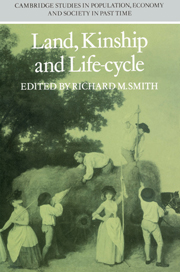Book contents
- Frontmatter
- Contents
- List of contributors
- Preface
- 1 Some issues concerning families and their property in rural England 1250–1800
- 2 Population pressure, inheritance and the land market in a fourteenth-century peasant community
- 3 Families and their land in an area of partible inheritance: Redgrave, Suffolk 1260–1320
- 4 Population changes and the transfer of customary land on a Cambridgeshire manor in the fourteenth century
- 5 Industrial employment and the rural land market 1380– 1520
- 6 Changes in the size of peasant holdings in some west midland villages 1400–1540
- 7 The erosion of the family–land bond in the late fourteenth and fifteenth centuries: a methodological note
- 8 Changes in the link between families and land in the west midlands in the fourteenth and fifteenth centuries
- 9 Kinship in an English village: Terling, Essex 1550–1700
- 10 The myth of the peasantry: family and economy in a northern parish
- 11 Poverty, poor relief and the life-cycle: some evidence from seventeenth-century Norfolk
- 12 The receipt of poor relief and family situation: Aldenham, Hertfordshire 1630–90
- 13 Widows in pre-industrial society: an essay upon their economic functions
- 14 Real property, marriage and children: the evidence from four pre-industrial communities
- 15 The nineteenth-century peasantry of Melbourn, Cambridgeshire
- Consolidated Bibliography
- Index
14 - Real property, marriage and children: the evidence from four pre-industrial communities
Published online by Cambridge University Press: 19 October 2009
- Frontmatter
- Contents
- List of contributors
- Preface
- 1 Some issues concerning families and their property in rural England 1250–1800
- 2 Population pressure, inheritance and the land market in a fourteenth-century peasant community
- 3 Families and their land in an area of partible inheritance: Redgrave, Suffolk 1260–1320
- 4 Population changes and the transfer of customary land on a Cambridgeshire manor in the fourteenth century
- 5 Industrial employment and the rural land market 1380– 1520
- 6 Changes in the size of peasant holdings in some west midland villages 1400–1540
- 7 The erosion of the family–land bond in the late fourteenth and fifteenth centuries: a methodological note
- 8 Changes in the link between families and land in the west midlands in the fourteenth and fifteenth centuries
- 9 Kinship in an English village: Terling, Essex 1550–1700
- 10 The myth of the peasantry: family and economy in a northern parish
- 11 Poverty, poor relief and the life-cycle: some evidence from seventeenth-century Norfolk
- 12 The receipt of poor relief and family situation: Aldenham, Hertfordshire 1630–90
- 13 Widows in pre-industrial society: an essay upon their economic functions
- 14 Real property, marriage and children: the evidence from four pre-industrial communities
- 15 The nineteenth-century peasantry of Melbourn, Cambridgeshire
- Consolidated Bibliography
- Index
Summary
Introduction
If land is to yield a profit or even a livelihood to its possessors it has to be worked. Whether the labour comes from the family or is hired depends on the size of the enterprise, the nature of the agricultural activity (some demanding more labour than others), and the ease with which non-family labour may be purchased. It would seem to follow, therefore, that land must influence the composition of the possessor's household. More precisely it could be said that this should contain (though not, of course, at all stages of its development) either offspring of working age, or farm servants who live in or even kin in need of employment or shelter, or one or more of these in various combinations. If land were the only economic influence on household forms we might risk a further prediction that possessors of land would have larger, more complex households with more servants and adult offspring than those without, always assuming of course that such economic influences are not overridden by cultural or social-status ones.
However, if we are thinking in terms of English villages, the influence of non-farming occupation has also to be considered and has indeed already been observed to have an important bearing on household structure. Peter Laslett, for example, has demonstrated for pre-industrial England that gentry households more often contained kin and servants than did yeoman households and that the proportion of yeoman households with kin and servants exceeded in turn those of the husbandmen as those of the husbandmen did the tradesmen and craftsmen and so on down the status hierarchy until one reached paupers with the smallest households, fewest servants and fewest kin.
- Type
- Chapter
- Information
- Land, Kinship and Life-Cycle , pp. 443 - 480Publisher: Cambridge University PressPrint publication year: 1985
- 1
- Cited by

